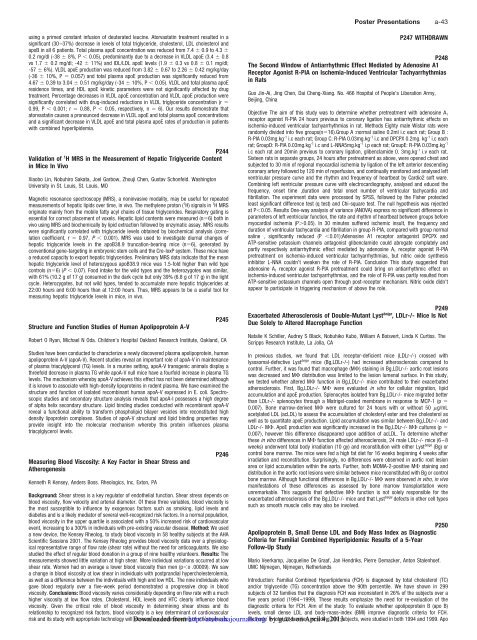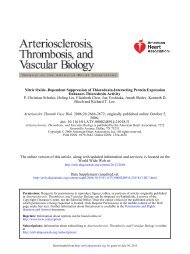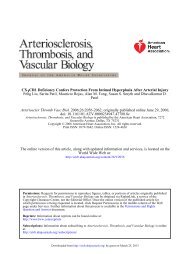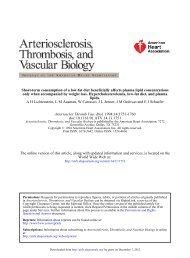Oral Presentations - Arteriosclerosis, Thrombosis, and Vascular ...
Oral Presentations - Arteriosclerosis, Thrombosis, and Vascular ...
Oral Presentations - Arteriosclerosis, Thrombosis, and Vascular ...
Create successful ePaper yourself
Turn your PDF publications into a flip-book with our unique Google optimized e-Paper software.
using a primed constant infusion of deuterated leucine. Atorvastatin treatment resulted in a<br />
significant (30–37%) decrease in levels of total triglyceride, cholesterol, LDL cholesterol <strong>and</strong><br />
apoB in all 6 patients. Total plasma apoE concentration was reduced from 7.4 0.9 to 4.3 <br />
0.2 mg/dl (-38 8%, P 0.05), predominantly due to a decrease in VLDL apoE (3.4 0.8<br />
vs 1.7 0.2 mg/dl; -42 11%) <strong>and</strong> IDL/LDL apoE levels (1.9 0.3 vs 0.8 0.1 mg/dl;<br />
-57 6%). VLDL apoE production was reduced from 3.82 0.67 to 2.26 0.42 mg/kg/day<br />
(-36 10%, P 0.057) <strong>and</strong> total plasma apoE production was significantly reduced from<br />
4.67 0.39 to 3.04 0.51 mg/kg/day (-34 10%, P 0.05). VLDL <strong>and</strong> total plasma apoE<br />
residence times, <strong>and</strong> HDL apoE kinetic parameters were not significantly affected by drug<br />
treatment. Percentage decreases in VLDL apoE concentration <strong>and</strong> VLDL apoE production were<br />
significantly correlated with drug-induced reductions in VLDL triglyceride concentration (r <br />
0.99, P 0.001; r 0.88, P 0.05, respectively, n 6). Our results demonstrate that<br />
atorvastatin causes a pronounced decrease in VLDL apoE <strong>and</strong> total plasma apoE concentrations<br />
<strong>and</strong> a significant decrease in VLDL apoE <strong>and</strong> total plasma apoE rates of production in patients<br />
with combined hyperlipidemia.<br />
P244<br />
Validation of 1 H MRS in the Measurement of Hepatic Triglyceride Content<br />
in Mice In Vivo<br />
Xiaobo Lin, Nobuhiro Sakata, Joel Garbow, Zhouji Chen, Gustav Schonfeld. Washington<br />
University in St. Louis, St. Louis, MO<br />
Magnetic resonance spectroscopy (MRS), a noninvasive modality, may be useful for repeated<br />
measurements of hepatic lipids over time, in vivo. The methylene proton ( 1 H) signals in 1 H MRS<br />
originate mainly from the mobile fatty acyl chains of tissue triglycerides. Respiratory gating is<br />
essential for correct placement of voxels. Hepatic lipid contents were measured (n6) both in<br />
vivo using MRS <strong>and</strong> biochemically by lipid extraction followed by enzymatic assay. MRS results<br />
were significantly correlated with triglyceride levels obtained by biochemical analysis (correlation<br />
coefficient, r 0.97, P 0.001). MRS was used to investigate diurnal changes of<br />
hepatic triglyceride levels in the apoB38.9 truncation-bearing mice (n6), generated by<br />
conventional gene-targeting in embryonic stem cells <strong>and</strong> the Cre-loxP system. These mice have<br />
a reduced capacity to export hepatic triglycerides. Preliminary MRS data indicate that the mean<br />
hepatic triglyceride level of heterozygous apoB38.9 mice was 1.5-fold higher than wild type<br />
controls (n6) (P 0.07). Food intake for the wild types <strong>and</strong> the heterozygotes was similar,<br />
with 61% (10.2 g of 17 g) consumed in the dark cycle but only 39% (6.8 g of 17 g) in the light<br />
cycle. Heterozygotes, but not wild types, tended to accumulate more hepatic triglycerides at<br />
22:00 hours <strong>and</strong> 6:00 hours than at 12:00 hours. Thus, MRS appears to be a useful tool for<br />
measuring hepatic triglyceride levels in mice, in vivo.<br />
Structure <strong>and</strong> Function Studies of Human Apolipoprotein A-V<br />
P245<br />
Robert O Ryan, Michael N Oda. Children’s Hospital Oakl<strong>and</strong> Research Institute, Oakl<strong>and</strong>, CA<br />
Studies have been conducted to characterize a newly discovered plasma apolipoprotein, human<br />
apolipoprotein A-V (apoA-V). Recent studies reveal an important role of apoA-V in maintenance<br />
of plasma triacylglycerol (TG) levels. In a murine setting, apoA-V transgenic animals display a<br />
threefold decrease in plasma TG while apoA-V null mice have a fourfold increase in plasma TG<br />
levels. The mechanism whereby apoA-V achieves this effect has not been determined although<br />
it is known to associate with high-density lipoproteins in rodent plasma. We have examined the<br />
structure <strong>and</strong> function of isolated recombinant human apoA-V expressed in E. coli. Spectroscopic<br />
studies <strong>and</strong> secondary structure analysis reveals that apoA-I possesses a high degree<br />
of alpha helix secondary structure. Lipid binding studies conducted with recombinant apoA-V<br />
reveal a functional ability to transform phospholipid bilayer vesicles into reconstituted high<br />
density lipoprotein complexes. Studies of apoA-V structural <strong>and</strong> lipid binding properties may<br />
provide insight into the molecular mechanism whereby this protein influences plasma<br />
triacylglycerol levels.<br />
Measuring Blood Viscosity: A Key Factor in Shear Stress <strong>and</strong><br />
Atherogenesis<br />
Kenneth R Kensey, Anders Boss. Rheologics, Inc, Exton, PA<br />
P246<br />
Background: Shear stress is a key regulator of endothelial function. Shear stress depends on<br />
blood viscosity, flow velocity <strong>and</strong> arterial diameter. Of these three variables, blood viscosity is<br />
the most susceptible to influence by exogenous factors such as smoking, lipid levels <strong>and</strong><br />
diabetes <strong>and</strong> is a likely mediator of several well-recognized risk factors. In a normal population,<br />
blood viscosity in the upper quartile is associated with a 50% increased risk of cardiovascular<br />
event, increasing to a 300% in individuals with pre-existing vascular disease. Method: We used<br />
a new device, the Kensey Rheolog, to study blood viscosity in 58 healthy subjects at the AHA<br />
Scientific Sessions 2001. The Kensey Rheolog provides blood viscosity data over a physiological<br />
representative range of flow rate (shear rate) without the need for anticoagulants. We also<br />
studied the effect of regular blood donation in a group of nine healthy volunteers. Results: The<br />
measurements showed little variation at high shear. More individual variations occurred at low<br />
shear rate. Women had on average a lower blood viscosity than men (po .00009). We saw<br />
a change in blood viscosity at low shear in individuals with postpr<strong>and</strong>ial hypercholesterolemia,<br />
as well as a difference between the individuals with high <strong>and</strong> low HDL. The nine individuals who<br />
gave blood regularly over a five-week period demonstrated a progressive drop in blood<br />
viscosity. Conclusions: Blood viscosity varies considerably depending on flow rate with a much<br />
higher viscosity at low flow rates. Cholesterol, HDL levels <strong>and</strong> HTC clearly influence blood<br />
viscosity. Given the critical role of blood viscosity in determining shear stress <strong>and</strong> its<br />
relationship to recognized risk factors, blood viscosity is a key determinant of cardiovascular<br />
risk <strong>and</strong> its study with appropriate technology willDownloaded increase our underst<strong>and</strong>ing from<br />
of atherogenesis.<br />
http://atvb.ahajournals.org/<br />
Poster <strong>Presentations</strong> a-43<br />
P247 WITHDRAWN<br />
P248<br />
The Second Window of Antiarrhythmic Effect Mediated by Adenosine A1<br />
Receptor Agonist R-PIA on Ischemia-Induced Ventricular Tachyarrhythmias<br />
in Rats<br />
Guo Jin-Ai, Jing Chen, Dai Cheng-Xiang. No. 466 Hospital of People’s Liberation Army,<br />
Beijing, China<br />
Objective The aim of this study was to determine whether pretreatment with adenosine A 1<br />
receptor agonist R-PIA 24 hours previous to coronary ligation has antiarrhythmic effects on<br />
ischemia-induced ventricular tachyarrhythmias in rat. Methods Eighty male Wistar rats were<br />
r<strong>and</strong>omly divided into five groups(n16).Group A :normal saline 0.2ml i.c each rat; Group B :<br />
R-PIA 0.03mg.kg -1 i.c each rat; Group C: R-PIA 0.03mg.kg -1 i.c <strong>and</strong> DPCPX 0.2mg. kg -1 i.c each<br />
rat; GroupD: R-PIA 0.03mg.kg -1 i.c <strong>and</strong> L-NNA5mg.kg -1 i.p each rat; GroupE: R-PIA 0.03mg.kg -1<br />
i.c each rat <strong>and</strong> 20min previous to coronary ligation, glibenclamide 0. 3mg.kg -1 i.v each rat.<br />
Sixteen rats in separate groups, 24 hours after pretreatment as above, were opened chest <strong>and</strong><br />
subjected to 30 min of regional myocardial ischemia by ligation of the left anterior descending<br />
coronary artery followed by 120 min of reperfusion, <strong>and</strong> continually monitored <strong>and</strong> analysed left<br />
ventricular pressure curve <strong>and</strong> the rhythm <strong>and</strong> frequency of heartbeat by Cardio2 soft ware.<br />
Combining left ventricular pressure curve with electrocardiography, analysed <strong>and</strong> educed the<br />
frequency, onset time ,duration <strong>and</strong> total onset number of ventricular tachycardia <strong>and</strong><br />
fibrillation. The experiment data were processed by SPSS, followed by the Fisher protected<br />
least significant difference test (q test) <strong>and</strong> Chi-square test. The null hypothesis was rejected<br />
at P0.05. Results One-way analysis of variance (ANOVA) express no significant difference in<br />
parameters of left ventricular function, the rate <strong>and</strong> rhythm of heartbeat between groups before<br />
myocardial ischemia (P0.05). In 30 minutes suffered ischemic insult, the frequency <strong>and</strong><br />
duration of ventricular tachycardia <strong>and</strong> fibrillation in group R-PIA, compared with group normal<br />
saline , significantly reduced (P 0.01);Adenosine A1 receptor antagonist DPCPX <strong>and</strong><br />
ATP-sensitive potassium channels antagonist glibenclamide could abrogate complately <strong>and</strong><br />
partly respectively antiarrhythmic effect mediated by adenosine A 1 receptor agonist R-PIA<br />
pretreatment on ischemia-induced ventricular tachyarrhythmias, but nitric oxide synthesis<br />
inhibitor L-NNA couldn’t weaken the role of R-PIA. Conclusion This study suggested that<br />
adenosine A 1 receptor agonist R-PIA pretreatment could bring on antiarrhythmic effect on<br />
ischemia-induced ventricular tachyarrhythmias, <strong>and</strong> the role of R-PIA was partly resulted from<br />
ATP-sensitive potassium channels open through post-receptor mechanism. Nitric oxide didn’t<br />
appear to participate in triggering mechanism of above the role.<br />
P249<br />
Exacerbated Atherosclerosis of Double-Mutant Lyst beige , LDLr-/- Mice Is Not<br />
Due Solely to Altered Macrophage Function<br />
Natalie K Schiller, Audrey S Black, Nobuhiko Kubo, William A Boisvert, Linda K Curtiss. The<br />
Scripps Research Institute, La Jolla, CA<br />
In previous studies, we found that LDL receptor-deficient mice (LDLr-/-) crossed with<br />
lysosomal-defective Lyst beige mice (Bg,LDLr-/-) had increased atherosclerosis compared to<br />
control. Further, it was found that macrophage (M) staining in Bg,LDLr-/- aortic root lesions<br />
was decreased <strong>and</strong> M distribution was limited to the lesion lumenal surface. In this study,<br />
we tested whether altered M function in Bg,LDLr-/- mice contributed to their exacerbated<br />
atherosclerosis. First, Bg,LDLr-/- M were evaluated in vitro for cellular migration, lipid<br />
accumulation <strong>and</strong> apoE production. Splenocytes isolated from Bg,LDLr-/- mice migrated better<br />
than LDLr-/- splenocytes through a Matrigel-coated membrane in response to MCP-1 (p <br />
0.007). Bone marrow-derived M were cultured for 24 hours with or without 50 g/mL<br />
acetylated LDL (acLDL) to assess the accumulation of cholesteryl ester <strong>and</strong> free cholesterol as<br />
well as to quantitate apoE production. Lipid accumulation was similar between Bg,LDLr-/- <strong>and</strong><br />
LDLr-/- M. ApoE production was significantly increased in the Bg,LDLr-/- M cultures (p <br />
0.007), however this difference disappeared upon addition of acLDL. To determine whether<br />
these in vitro differences in M function affected atherosclerosis, 24 male LDLr-/- mice (6–8<br />
weeks) underwent total body irradiation (10 gy) <strong>and</strong> reconstitution with either Lyst beige (Bg) or<br />
control bone marrow. The mice were fed a high fat diet for 16 weeks beginning 4 weeks after<br />
irradiation <strong>and</strong> reconstitution. Surprisingly, no differences were observed in aortic root lesion<br />
area or lipid accumulation within the aorta. Further, both MOMA-2-positive M staining <strong>and</strong><br />
distribution in the aortic root lesions were similar between mice reconstituted with Bg or control<br />
bone marrow. Although functional differences in Bg,LDLr-/- M were observed in vitro, in vivo<br />
manifestations of these differences as assessed by bone marrow transplantation were<br />
unremarkable. This suggests that defective M function is not solely responsible for the<br />
exacerbated atherosclerosis of the Bg,LDLr-/- mice <strong>and</strong> that Lyst beige defects in other cell types<br />
such as smooth muscle cells may also be involved.<br />
P250<br />
Apolipoprotein B, Small Dense LDL <strong>and</strong> Body Mass Index as Diagnostic<br />
Criteria for Familial Combined Hyperlipidemia: Results of a 5-Year<br />
Follow-Up Study<br />
Mario Veerkamp, Jacqueline De Graaf, Jan Hendriks, Pierre Demacker, Anton Stalenhoef.<br />
UMC Nijmegen, Nijmegen, Netherl<strong>and</strong>s<br />
Introduction: Familial Combined Hyperlipidemia (FCH) is diagnosed by total cholesterol (TC)<br />
<strong>and</strong>/or triglyceride (TG) concentration above the 90th percentile. We have shown in 299<br />
subjects of 32 families that the diagnosis FCH was inconsistent in 26% of the subjects over a<br />
five years period (1994–1999). These results emphasize the need for re-evaluation of the<br />
diagnostic criteria for FCH. Aim of the study: To evaluate whether apolipoprotein B (apo B)<br />
levels, small dense LDL <strong>and</strong> body-mass-index (BMI) improve diagnostic criteria for FCH.<br />
Methods: In by total guest 32 families, on April including 4, 2013 299 subjects, were studied in both 1994 <strong>and</strong> 1999. Apo














